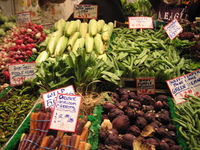
There is no doubt that a healthy lifestyle will include a lot of vegetables. We are talking vegetables here – not salads – salads and soups are for another chapter. When I challenged my patients to come up with a list of vegetables—a group of sixty came up with 12 vegetables. When they came up with desserts – they came up with 20. But this year my support group did even better- and we had a vegetable cook off so some of those recipes (modified a bit by me) are listed here.
Vegetables are an important topic- and if you have a goal- it should be to try some new vegetable dish once a week. If you do that- you will find some you like- and some you cannot simply stand.
Vegetables are divided into several categories – leafy and salad vegetables that include amaranth, arugula, bok choy, broccoli rabe, Brussels sprout, Celery, Chard, Dandelion, Endive, Kale, Lettuce (of course), Mustard, Spinach, Turnip greens, Watercress, and Yarro.
Some mistake fruits for vegetables – and those common ones are avocado, bell peppers, cucumber, eggplant, sweet corn, tomato, winter melon, and zucchini.
Flowers and flower buds make up another source such as Artichoke, broccoli, cauliflower, and squash blossoms.
Legumes are a favorite of mine because they are typically less fattening. Among those are the Azuki bean, black-eyed peas, chickpeas, fava beans, green beans, lentils, lima beans, okra, peas, peanuts, soybeans, and yardlong beans. You will find a great recipe for hummus here also.
Bud and stem vegetables include asparagus, celery, garlic, leeks, onions, and leeks.
Toot and tuberous vegetables include the bamboo shoot, carrots, Chinese artichoke, elephant yam, ginger, Jerusalem artichoke, parsnip, the potato, radish, rutabaga, sweet potato, turnip, and yam.
Sea vegetables are also becoming popular as a source of iodine and these include aonori, carola, laver, nori, sea grape, seakale, sea lettuce, and wakame.
The nutrients that vegetables take in from the ground, concentrate, and present to people are essential to good health.
The common myth is that raw vegetables are better than cooked. This myth is based on chemistry- if you take a raw vegetable and place it into an instrument to calculate minerals and vitamins then cook it and re check, there are fewer nutrients in the cooked than in the raw. However, people are not scientific instruments. Most vegetables contain methylcellulose – something that humans cannot break down. So the only way to get at the minerals and vitamins in the vegetables is to cook them. If you eat raw vegetables and we take blood from you to see the nutrients it will be less than if you cook the vegetables. Ah yes- another myth that mom told us.
